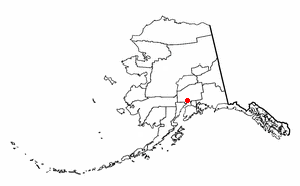Yentna River
| Yentna River | |
|---|---|
| Origin |
62°16′50″N 151°46′26″W / 62.28056°N 151.77389°W[1] East Fork Yentna River and West Fork Yentna River Matanuska-Susitna Borough, Alaska |
| Mouth |
61°33′38″N 150°29′4″W / 61.56056°N 150.48444°WCoordinates: 61°33′38″N 150°29′4″W / 61.56056°N 150.48444°W[1] Susitna River Matanuska-Susitna Borough, Alaska |
| Basin countries | United States of America |
| Length | 75 mi (121 km)[1] |
| Source elevation | 200 ft (61 m)[2][3] |
| Mouth elevation | 26 ft (7.9 m)[1] |
The Yentna River[4] is a river in South Central Alaska, formed by its East Fork[2] and West Fork[3] at 62°16′50″N 151°46′26″W / 62.28056°N 151.77389°W,[1] flows South-East to Susitna River, 30 miles (48 km) North-West of Anchorage, Alaska; Cook Inlet Low.[1]
History
Tanaina Indian name reported by Spurr (1900, p. 46), United States Geological Survey. "Sometimes called Johnson River after the first white man to ascend it."[1]
Watershed

It begins in the Mount Dall and Yentna glacier systems and flows southeast to the Susitna River 2 miles (3.2 km) north of Susitna. The river system (including upstream tributaries) is about 100 miles (160 km) long.
Tributaries
From mouth to source:
- Kahiltna River 61°51′11″N 150°46′46″W / 61.85306°N 150.77944°W, Elevation: 75 feet (23 m) [5]
- Bottle Creek (Yentna River) 61°57′49″N 151°4′44″W / 61.96361°N 151.07889°W, Elevation: 125 feet (38 m) [6]
- Skwentna River 61°59′8″N 151°8′23″W / 61.98556°N 151.13972°W, Elevation: 125 feet (38 m) [7]
- East Fork Yentna River 62°16′49″N 151°46′26″W / 62.28028°N 151.77389°W, Elevation: 200 feet (61 m) [2]
- West Fork Yentna River 62°16′49″N 151°46′26″W / 62.28028°N 151.77389°W, Elevation: 200 feet (61 m) [3]
Lake Creek just about 3 miles down river from Bottle Creek. Major fishing area kings,reds,silvers, Winter sports, hunting.
See also
References
- ↑ 1.0 1.1 1.2 1.3 1.4 1.5 1.6 "Yentna River". Geographic Names Information System, U.S. Geological Survey. Retrieved 2009-05-03.
- ↑ 2.0 2.1 2.2 "East Fork Yetna River". Geographic Names Information System, U.S. Geological Survey. Retrieved 2009-05-03.
- ↑ 3.0 3.1 3.2 "West Fork Yetna River". Geographic Names Information System, U.S. Geological Survey. Retrieved 2009-05-03.
- ↑ United States Geological Survey Hydrological Unit Code:
- ↑ "Kahiltna River". Geographic Names Information System, U.S. Geological Survey. Retrieved 2009-05-03.
- ↑ "Bottle Creek (Yentna River)". Geographic Names Information System, U.S. Geological Survey. Retrieved 2009-05-03.
- ↑ "Skwentna River". Geographic Names Information System, U.S. Geological Survey. Retrieved 2009-05-03.